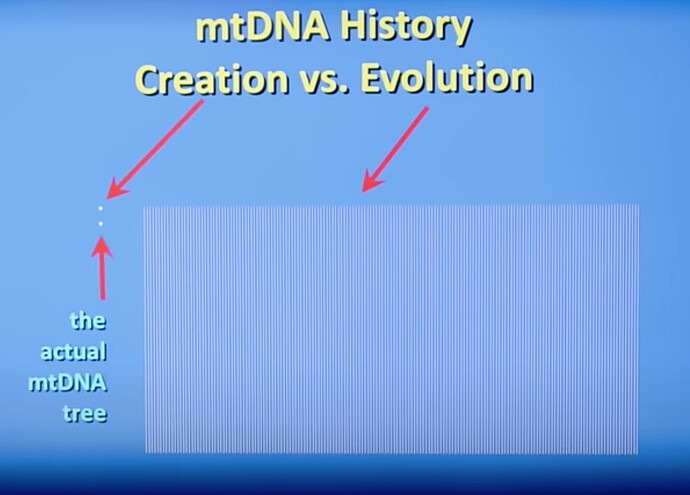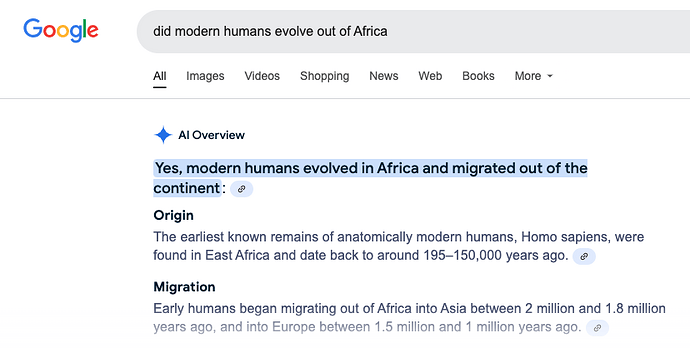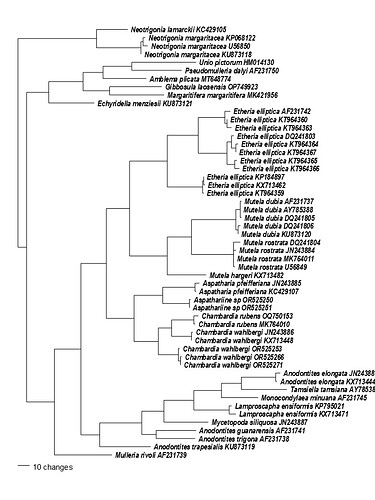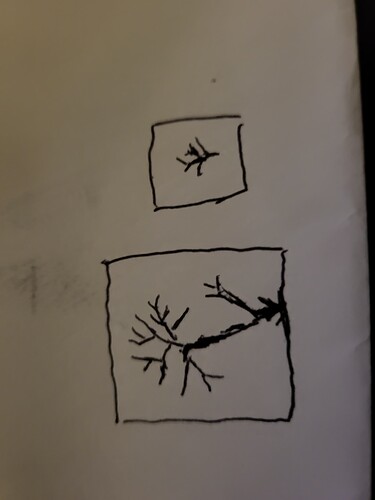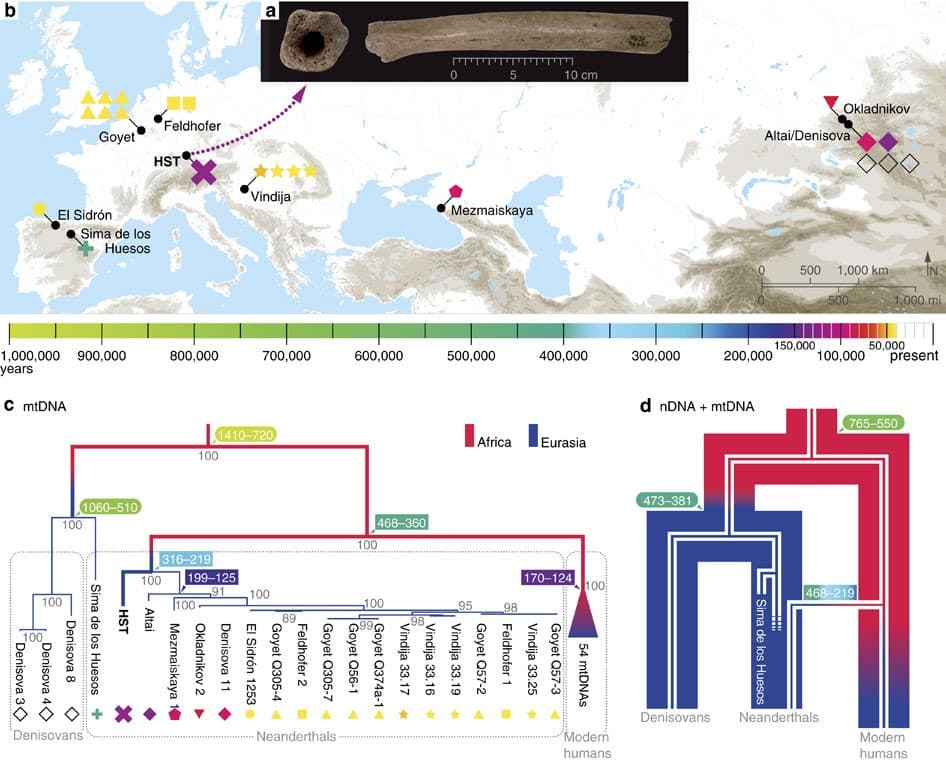" [quote=“paleomalacologist, post:5, topic:53824”]
Over time some women have daughters and pass on their mitochondrial genes. Others only have sons, or have no children, and don’t pass on their mitochondrial genes.
[/quote]
That is not a relevant argument."
It is basic to what Wise is claiming and to understanding the issue here.
Wise has not presented an illustration of the evolutionary view. He has presented an illustration that makes no sense whatsoever from an evolutionary viewpoint and called it the evolutionary view. The reality is that there are multiple possible patterns within an evolutionary context, but the one he drew does not make sense as an evolutionary pattern. Also, this is talking about variation within humans; dismissing that as evolutionary is silly.
One complicating factor in your request for visual illustrations is that there are multiple ways to draw diagrams of the same information. Here’s an analysis of some mitochondrial gene data, though not for humans, which I am currently working on:
Wise’s pictures use a star tree style, whereas this shows the branching pattern rectangularly. There are a series of branching events, with various amounts of change on the different branches.
Neotrigonia forms the oldest branch relative to the others, for example. In this diagram (unlike some others), the branch lengths indicate the amount of change, so you can see that there is relatively little variation within
Neotrigonia margaritacea and somewhat more difference with
N. lamarckii. Mitochondria take organic molecules and break them down into carbon dioxide and water, using oxygen and producing energy-rich ATP. Practically all eukaryotes depend on this process for cell energy - try not breathing, or using cyanide to stop your mitochondria from functioning, and you’ll quickly see that mitochondria are important. But there is plenty of variation in mitochondrial DNA, enough to detect broad-level patterns of relationships within species. This is basic to what Wise is saying. Mitochondrial DNA can trace relationships between humans (almost entirely along the female line) because it mutates quickly enough to have noticeable differences within humanity.
If one denies that any evolution whatsoever happens, then the predicted pattern would look like this: . Just a dot, no branches of any length. No change. That does not match the observed pattern.
Admitting that DNA does change within species over time, the basic patterns expected would be a series of branches, not unlike the tree above. This is true regardless of how humanity originated. What would be different between a young-earth model with separate creation of humans from other organisms? The two main differences would be that the young-earth timeline should have fewer total changes, as there has been less time for changes to accumulate, and that the branching pattern should not fit if we add non-human DNA data into the analysis. The difference would look something like this:
The top tree has shorter branches and does not connect to anything else.
But in fact, what we observe is a level of mutations that is consistent with a roughly 170,000 year time frame from the last common ancestor of human mitochondria to the present. The deepest divides are between various African groups; the Asian and European groups split off much more recently than the deepest divides within Africa (see, for example, https://www.pnas.org/doi/full/10.1073/pnas.0136972100, published in 2002). The claim that the splits fit with a Europe-Asia-Africa split is not true. European and some Asian together form one of the main non-African subgroups, and the other non-African subgroup is basically all from Asia.
Inheritance patterns get complicated, and there is actually no particular reason to assume that a modern young-earth model of human origins would produce any specific geographic pattern. (A geographic pattern is expected, but what that pattern would be is not certain.) We do not have any information on how closely related Noah’s sons’ wives were. Nor do we know whose daughters married whom or who had no daughters.
But we also see that the tree containing modern human sequences is yet more distantly related to sequences for Neanderthals, Denisovians, and other extinct groups within the genus Homo. In turn, this set of sequences is most similar to that of chimpanzees, and then to gorillas, and so on to other mammals and beyond until the DNA becomes too different to see very meaningful patterns. This nested hierarchy should not be present if creation of humans and the others did not use an evolutionary pattern. All mammals need working mitochondria. Some of the needed genes are in the nucleus and some in the mitochondrion, but as long as all of those are working together properly and the mitochondrion puts out enough ATP, that’s what’s necessary. There’s no functional reason why a chimp needs to have its mitochondrial genes more similar to ours than to a squirrel’s or a monkey’s, or even to a plant’s. Yeast can survive having their mitochondrial DNA replaced by mammal mitochondrial DNA (Intramitochondrial transfer and engineering of mammalian mitochondrial genomes in yeast - ScienceDirect). The fact that the mitochondrial DNA trees connect human and chimp DNA is a serious problem for claims that there is no evolutionary connection between the two. In fact, the split between Neotrigonia and the other clams in my diagram is far older than the split between humans and chimps.
Why do mitochondria have DNA in the first place? Having DNA in the nucleus works fine for most other organelles (except chloroplasts). It turns out that mitochondrial DNA for eukaryotes as a whole shows similarities to certain alpha proteobacteria, whereas nuclear DNA has greatest ties to certain Archaea. Mitochondrial DNA strongly supports the idea that the mitochondria themselves were created through evolution from a bacterium and an archaean that lived in close association until the bacterium was surrounded by the archaean, becoming a part of the cell.
Thus, overall, Wise’s argument has taken real data, selected a diagram that is somewhat misleading, completely misrepresented what should be expected under an evolutionary model, invented a supposedly young-earth model, and claimed that the data fit the young-earth model when they don’t. It has also ignored a huge amount of additional related data that clearly support an ancient earth and evolutionary methods of creation.
If you wish to credibly promote a young-earth position, you need to pay attention to the problems with young-earth arguments. A bad argument discredits your position; you need to strive to eliminate bad arguments rather than repeating anything that seems to support your view and ignoring the problems. Also, you need to pay attention to the overall pattern. It’s not honest to argue “what about A?” “That’s wrong, and here’s why”. “What about B?” “That’s wrong, and here’s why”. “What about C?” “That’s wrong, and here’s why”. “What about D?” “That’s wrong, and here’s why”. “What about E?” “That’s wrong, and here’s why”. “What about A?”
Your phone is made of resources that were located by use of old-earth models. Young-earth models have never produced any practical geological information; they only exist for the sake of trying to deny the evidence that the earth is old, not to actually understand the workings of God’s creation.
If the evidence actually supported a young earth, I would have no problem with it. God is free to create however He wishes. I object to young-earth arguments because they are not honest, not because they are young-earth.
